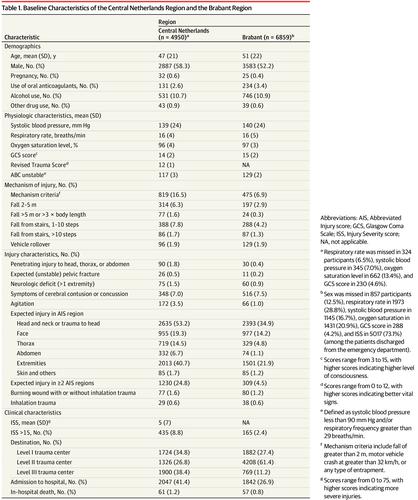JAMA Surgery ( IF 15.7 ) Pub Date : 2019-05-01 , DOI: 10.1001/jamasurg.2018.4752 Eveline A. J. van Rein 1 , Rogier van der Sluijs 1 , Frank J. Voskens 1 , Koen W. W. Lansink 2, 3 , R. Marijn Houwert 1, 3 , Rob A. Lichtveld 4 , Mariska A. de Jongh 5 , Marcel G. W. Dijkgraaf 6 , Howard R. Champion 7, 8 , Frank J. P. Beeres 9 , Luke P. H. Leenen 1 , Mark van Heijl 1, 10

|
Importance Prehospital trauma triage protocols are used worldwide to get the right patient to the right hospital and thereby improve the chance of survival and avert lifelong disabilities. The American College of Surgeons Committee on Trauma set target levels for undertriage rates of less than 5%. None of the existing triage protocols has been able to achieve this target in isolation.
Objective To develop and validate a new prehospital trauma triage protocol to improve current triage rates.
Design, Setting, and Participants In this multicenter cohort study, all patients with trauma who were 16 years and older and transported to a trauma center in 2 different regions of the Netherlands were included in the analysis. Data were collected from January 1, 2012, through June 30, 2014, in the Central Netherlands region for the design data cohort and from January 1 through December 31, 2015, in the Brabant region for the validation cohort. Data were analyzed from May 3, 2017, through July 19, 2018.
Main Outcomes and Measures A new prediction model was developed in the Central Netherlands region based on prehospital predictors associated with severe injury. Severe injury was defined as an Injury Severity Score greater than 15. A full-model strategy with penalized maximum likelihood estimation was used to construct a model with 8 predictors that were chosen based on clinical reasoning. Accuracy of the developed prediction model was assessed in terms of discrimination and calibration. The model was externally validated in the Brabant region.
Results Using data from 4950 patients with trauma from the Central Netherlands region for the design data set (58.3% male; mean [SD] age, 47 [21] years) and 6859 patients for the validation Brabant region (52.2% male; mean [SD] age, 51 [22] years), the following 8 significant predictors were selected for the prediction model: age; systolic blood pressure; Glasgow Coma Scale score; mechanism criteria; penetrating injury to the head, thorax, or abdomen; signs and/or symptoms of head or neck injury; expected injury in the Abbreviated Injury Scale thorax region; and expected injury in 2 or more Abbreviated Injury Scale regions. The prediction model showed a C statistic of 0.823 (95% CI, 0.813-0.832) and good calibration. The cutoff point with a minimum specificity of 50.0% (95% CI, 49.3%-50.7%) led to a sensitivity of 88.8% (95% CI, 87.5%-90.0%). External validation showed a C statistic of 0.831 (95% CI, 0.814-0.848) and adequate calibration.
Conclusions and Relevance The new prehospital trauma triage prediction model may lower undertriage rates to approximately 10% with an overtriage rate of 50%. The next step should be to implement this prediction model with the use of a mobile app for emergency medical services professionals.
中文翻译:

创伤患者院前分流预测模型的开发与验证
重要性 院前创伤分诊规程在全球范围内用于将合适的患者送往合适的医院,从而提高生存机会并避免终身残疾。美国外科医生学院创伤委员会设定的未成年人分类率低于5%的目标水平。现有的分类服务协议中没有一个能够单独实现此目标。
目的 开发并验证一种新的院前创伤分诊方案,以提高目前的分诊率。
设计,环境和参与者 在这项多中心队列研究中,所有16岁及以上并被转运到荷兰2个不同地区的创伤中心的创伤患者都包括在分析中。从2012年1月1日至2014年6月30日在荷兰中部地区收集设计数据,从2015年1月1日至12月31日在Brabant地区收集验证数据。分析了2017年5月3日至2018年7月19日之间的数据。
主要结果和措施 基于与严重伤害相关的院前预测因素,荷兰中部地区开发了一种新的预测模型。严重伤害定义为伤害严重度得分大于15。使用具有惩罚性最大似然估计的完整模型策略来构建具有8种预测因子的模型,这些模型是根据临床推理选择的。根据区分度和校准度评估了开发的预测模型的准确性。该模型在布拉班特地区进行了外部验证。
结果 使用来自荷兰中部地区的4950名创伤患者的数据作为设计数据集(男性58.3%;平均[SD]年龄,47 [21]岁)和6859名患者用于验证布拉班特地区的数据(男性52.2%;平均[SD] ]年龄[51 [22]岁),则为预测模型选择了以下8个重要预测因子:年龄;收缩压; 格拉斯哥昏迷量表评分;机制标准;头部,胸部或腹部的穿透性损伤;头部或颈部受伤的体征和/或症状;简短伤害量表胸部区域的预期伤害;以及在2个或更多的简短伤害量表区域中的预期伤害。预测模型的C统计量为0.823(95%CI,0.813-0.832),并且校准良好。最低特异性为50.0%(95%CI,49.3%-50.7%)的临界点导致灵敏度为88.8%(95%CI,87.5%-90.0%)。
结论与相关性 新的院前创伤分诊预测模型可以将未成年人分流率降低至大约10%,而过度分流率为50%。下一步应该是使用针对紧急医疗服务专业人员的移动应用程序来实现此预测模型。









































 京公网安备 11010802027423号
京公网安备 11010802027423号